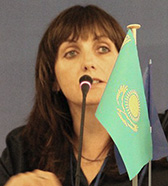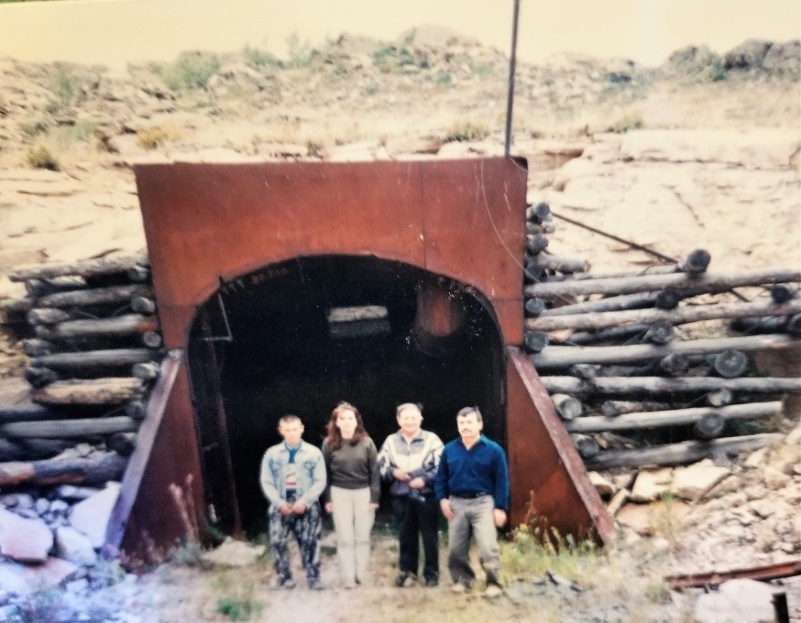LONDON – Fourteen years ago, the United Nations General Assembly (UNGA) declared Aug. 29 the International Day against Nuclear Tests. Initiated by Kazakhstan, its increasing relevance for the entire world community is fueled by sprawling geopolitical instability. In an interview with The Astana Times, Margarita Kalinina-Pohl, a U.S.-based expert in nuclear and radiological security, addressed ongoing challenges in nuclear disarmament and raised an importance of nonproliferation education.

The Stronger than Death monument in the Kazakh city of Semei. Photo credit: gov.kz.
Kalinina-Pohl is the director of the CBRN (Chemical, Biological, Radiological and Nuclear) Security Program at the James Martin Center for Nonproliferation Studies (CNS) with a 25-year work experience in education. The center is part of the Middlebury Institute of International Studies (MIIS) at Monterey, California. For this story, she shared intriguing insights of her research on nuclear and radiological security in Central Asia.
The legacy of nuclear testing
Christopher Nolan’s recently released film “Oppenheimer” about the creation of the atomic bomb during World War II remains a topic of heated discussions. However, the Hollywood movie, in her opinion, was “focused on the Trinity Test [the first detonation of the U.S. nuclear weapon] and its successful outcome, but it was silent about the human cost of local communities, known as the New Mexico ‘downwinders’.”

Margarita Kalinina-Pohl.
The Trinity nuclear test was part of the U.S.-led Manhattan Project, the code name for the scientific and military undertaking for the development of the first atomic bombs.
“Manhattan Project leaders did not inform people living nearby or downwind about the test, nor were Marshallese informed why they had to move from their land when nuclear atmospheric tests were conducted in the Pacific Ocean,” she said.
“The Soviets did the same to the Kazakh people living in the vicinity of the Semipalatinsk Test Site (STS),” she noted. “Nuclear tests were carried out there in complete secrecy and absolute denial of harmful effects of the radiation fallout.”
Nearly 1.5 million Kazakh people have suffered as a result of the 456 nuclear tests (340 underground and 116 aboveground) conducted for more than four decades at the Semipalatinsk polygon.
In the early 1990s, Kazakhstan faced an urgent need to secure dangerous materials, prevent brain drain, and start remediation and cleanup activities of the weapons of mass destruction (WMD). After the collapse of the Soviet Union, the country transferred nearly 1,400 Soviet nuclear warheads to Russia and joined the nonproliferation regime.
Kalinina-Pohl visited the Semipalatinsk polygon twice during her management activities at the CNS regional office in Kazakhstan. On her first private visit in 1999, she and her colleague from Switzerland had a tour to the experimental field (the former site for atmospheric nuclear tests) and to Degelen mountain (the tunnels for underground tests).
As for the second visit in 2001, she participated in a range of events commemorating the 10th anniversary of the STS closure organized by veterans of the Nevada-Semipalatinsk antinuclear movement, the first major anti-nuclear protest movement in the former Soviet Union. The official ceremony was held in the Kazakh city of Kurchatov and the program included another trip to the site.
“The encounters in Kurchatov and Semipalatinsk had a profound effect on me personally and professionally. It was an eye-opening experience that helped me realize the colossal efforts put into the tests and their large-scale impact on people and environment,” she said.
Another memory she shared from her visits was the impression from the Stronger Than Death monument, a memorial to the victims of nuclear tests. A mother under the nuclear mushroom shielding her child “depicts a powerful image.”
“In addition to dangerous nuclear materials at this site, the Soviet legacy left radioactive sources for military, research, and industrial purposes. On top of that, biological weapons were also produced in Kazakhstan. They were tested at Vozrozhdeniye Island in the Aral Sea,” she noted.
“The voices of the victims were silent for so long,” said Kalinina-Pohl. She emphasized that their true stories are being uncovered today, citing the example of works of a Kazakh artist and a nuclear disarmament activist Karipbek Kuyukov, who experienced firsthand consequences of nuclear tests at STS.
The book “Atomic Steppe: How Kazakhstan Gave Up the Bomb” written by a Kazakh prominent nuclear non-proliferation expert Togzhan Kassenova allowed Kalinina-Pohl to learn more about the plight of victims of nuclear tests in Kazakhstan. She recommended reading it, as “a full understanding of the complexity and soreness of the decision to close the test site came after this story.”
Nuclear and radiological security in Central Asia
This September marks another milestone in the history of nuclear disarmament – the 30th anniversary of the initiative to establish the Central Asian Nuclear-Weapon-Free Zone (CANWFZ). It led to the signing of the Treaty on a Nuclear-Weapon-Free Zone in Central Asia (Kazakhstan, Kyrgyzstan, Tajikistan, Turkmenistan, and Uzbekistan) in 2006 in the Kazakh city of Semei, also referred as the Treaty of Semipalatinsk.

Kuyukov showcases works at the EXPO 2020 Dubai. Photo credit: filipinotimes.net.
Kalinina-Pohl herself was born near one of the former uranium mine sites in Kyrgyzstan.
“Central Asian states – Kyrgyzstan and Tajikistan in particular – are still coping with the Soviet uranium mining legacy in the form of impoundments containing radioactive waste, known as tailings. They cause harm to people and the environment, representing a safety concern,” she said.
Along with other countries in the world, Central Asian states are also embarking on civilian nuclear energy programs.
“Uzbekistan is cooperating with Rosatom State Atomiс Energy Corporation on building a nuclear power plant. Kazakhstan is reviewing four potential bidders [from Korea, China, France, and Russia]. I consider the benefits of adding nuclear energy to countries’ energy portfolios as a step forward to reducing greenhouse gas emissions,” said the expert.
She underlined that Kazakhstan “does not fit in the category of a nuclear ‘newcomer,’ as the country is the world’s top uranium producer with an advanced nuclear infrastructure.”
The global nuclear order, in her opinion, has been challenged by an ongoing war in Ukraine.
“Senior Russia’s officials and experts have made unsettling statements alluding to the possibility of nuclear weapon use. The war has revealed the vulnerabilities of civilian nuclear infrastructure. We need to rethink how to address nuclear security in the changing geopolitical landscape, especially if such threats come from a nuclear-weapon state.”
Nonproliferation education
The expert underlined the growing relevance of nonproliferation education, suggesting that “nonproliferation should be taught not only at the university level, but it also should be introduced in high school curricula.”

Kalinina-Pohl (second from the left) in front of the entrance into Degelen mountain. Photo credit: Kalinina-Pohl’s personal archive.
CNS, for example, runs a program for high school students and teachers called Critical Issues Forum. Led by its manager and research associate Masako Toki, it allows students from the United States, Japan and, until recently, Russia to discuss the nonproliferation, arms control, and disarmament, and how they can contribute to reducing existential threats stemming from the WMD proliferation.
The program also includes virtual meetings with hibakushas, survivors of atomic bombings of Hiroshima and Nagasaki.
“It is widely recognized that the nonproliferation field is interdisciplinary. Preparing future nonproliferation leaders requires a holistic approach combining fluency in both technical and policy issues. Therefore, nonproliferation should be offered at both policy and technical universities that prepare future professionals for nuclear related fields,” she said.
According to Kalinina-Pohl, the program is one of the world’s first professional training programs devoted to WMD nonproliferation, arms control, and disarmament. It provides training, lectures, academic courses, independent research projects, and networking opportunities with leading experts from the United States and around the globe.
In the late 1990s, it included trainees from East Asia, and, in 2007, has expanded its activities to other regions to cover countries representing the Non-Aligned Movement (NAM). The program’s original focus was on practitioners and researchers from the Newly Independent States (NIS) of the former Soviet Union – Armenia, Azerbaijan, Belarus, Georgia, Kazakhstan, the Kyrgyz Republic, Moldova, Russia, Tajikistan, Turkmenistan, Ukraine, and Uzbekistan.
“Kazakhstan has been a hub for CNS activities from the late 1990s until 2009, when we maintained a regional representative office in Almaty. In the past two years we have revamped our presence in Central Asia, mostly in the field of radiological security and a regional initiative to promote women in nuclear fields,” she said.
Сooperation with Kazakh universities
Speaking about cooperation with Kazakh universities in nonproliferation education, the expert expressed the willingness to enhance it.
“We have trained a faculty member from the Nazarbayev University (NU). Besides, my colleagues and I visited its campus in 2014, where we discussed our possible cooperation with NU leadership.”
They also visited the Semei State University to give lectures on nuclear testing, and a few years earlier, CNS offered a one-time nonproliferation course at the Almaty-based Al-Farabi Kazakh National University (KazNU).
“I hope that we will revive our engagement with Kazakh universities,” she said.
Kalinina-Pohl participated in the training of more than 30 professionals from Kazakhstan, including representatives from the government, academic, and research institutions.
The expert underlined that, in addition to health impacts from nuclear testing, there are psychological and sociocultural consequences that are impossible to measure quantitatively.
“Numbers cannot do justice to victims of nuclear tests. Most of them are indigenous people and local communities, who lived through radioactive fallout from mushroom clouds mounting over deserts in the United States, over the Marshall Islands in the Pacific Ocean, the Kazakh steppe, and other territories where nuclear weapons were tested,” said Kalinina-Pohl.
“Given a 40-year history of nuclear tests in Kazakhstan, impacts of nuclear tests on people and environment are yet to be fully assessed for generations to come,” she added.
Kazakhstan’s longstanding commitment to nuclear disarmament resulted in its active participation in drafting and adoption of the Treaty on the Prohibition of Nuclear Weapons (TPNW). It was entered into force in an expedited manner in January 2021. The country’s chairmanship in TPNW by the end of this year will be mainly focused on victim assistance and environmental remediation.


